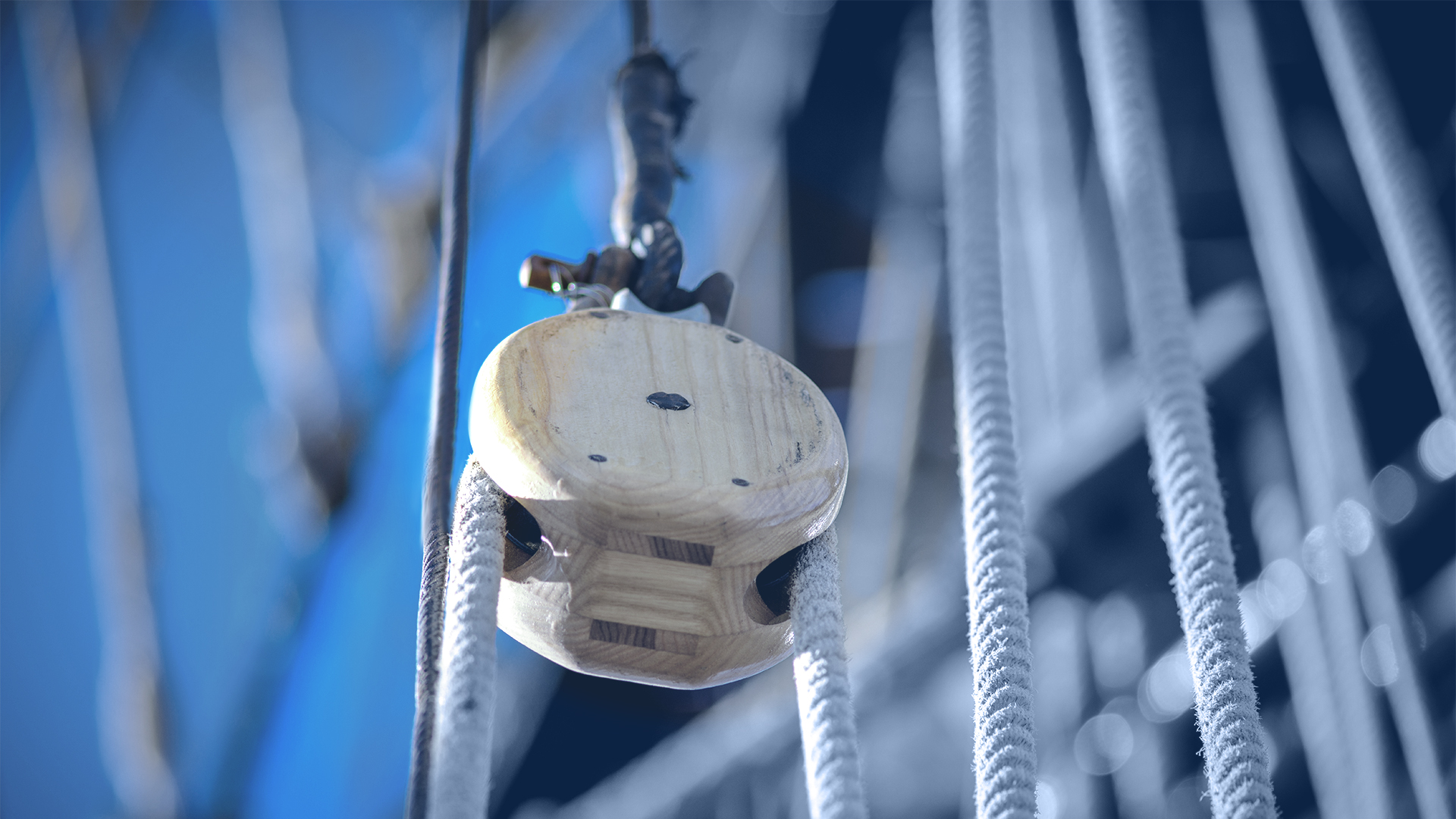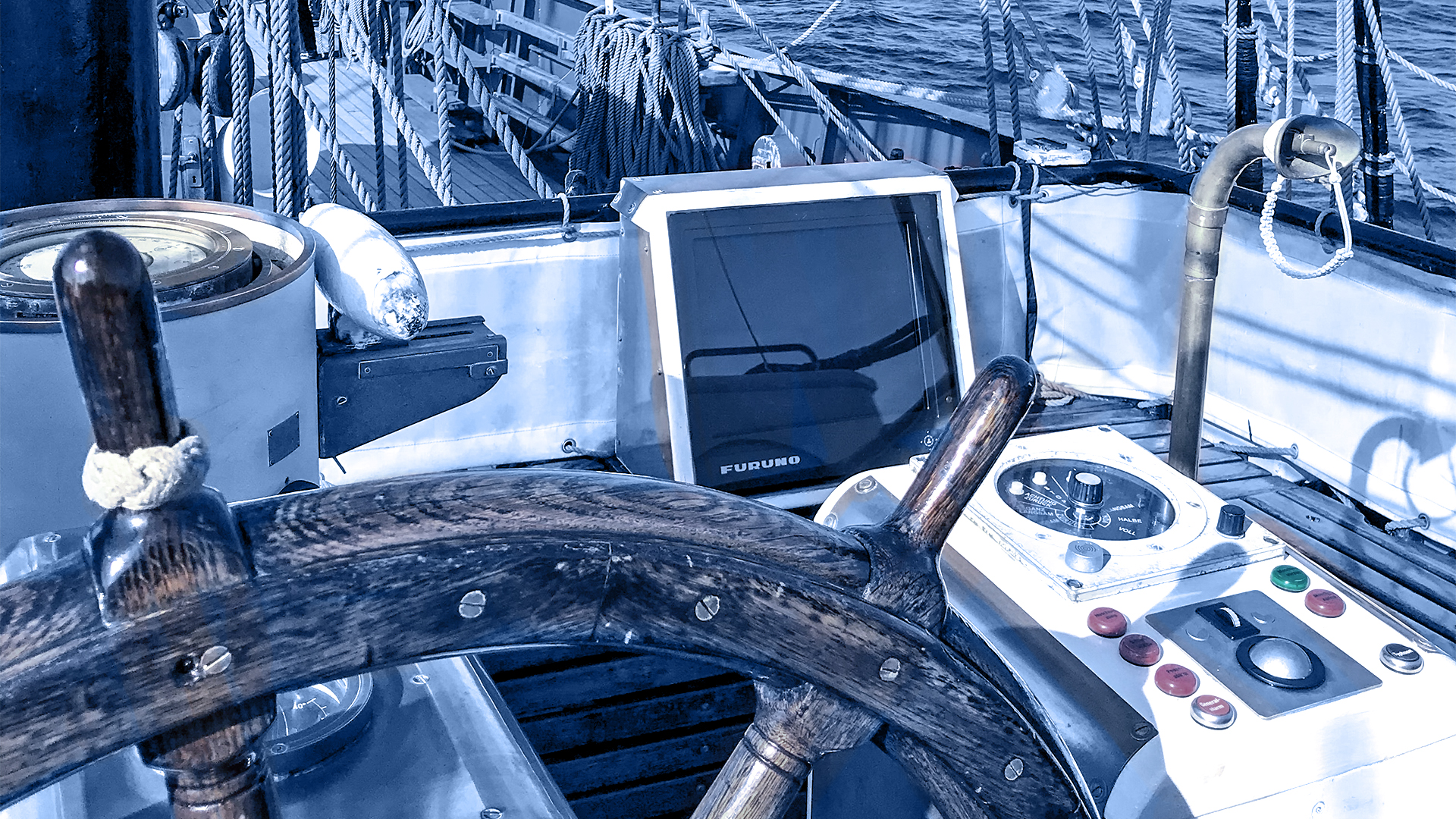How It All Began
From a decommissioned fishing logger to a proud brig…
It’s the year 1991. In the harbor of Neustadt, Schleswig-Holstein, on the Baltic Sea, a heavily modified fishing and tanker logger, originally built on the Elbe and now based in Peenemünde, is peacefully resting in a “sleep of the years.” Its time as a supply ship for the National People’s Navy of the GDR is long over. An abandoned wreck? A hidden gem!
This doesn’t go unnoticed in both East and West Germany for long. Two visionaries—one of whom is a co-founder of the association LebenLernen auf Segelschiffen—purchase the decommissioned hull, move the ship to Wolgast, and transform it into a proud brig in under two years: The birth of ROALD AMUNDSEN.
”Cast off!”
In August 1993, the ROALD made her first voyage under sail, commanded by Immo von Schnurbein, the former captain of the Gorch Fock, and he was impressed: “Very quickly, I came to appreciate the excellent maneuvering characteristics and outstanding sailing performance of the brig.”
The rest is history. Today, the ROALD AMUNDSEN is a floating monument: the result of hands-on, volunteer-driven work, a symbol of reunification, a piece of German history, and a powerful symbol of international understanding between East and West.
The Fascination of the Brig
“You experience in a truly unique way how small and yet vast this world is. It’s liberating when, together, we manage to overcome the harshest weather conditions, to cover great distances solely with the power of nature. And all of this through a craft that was thought to have died out a hundred years ago.”
— Captain Cornelia Rothkegel



1952–1990: The History of the VILM
… The design of the hull is that of a deep-sea fishing vessel. After the keel was laid and the hull completed, it was outfitted as a tanker, Tanklogger 235, at the VEB Roßlauer Shipyard for the former *Volkspolizei See* (VP-See) of the GDR. In April 1952, the logger was handed over by the shipyard and from then on, it primarily transported fuel between the VP-See’s bases. The tanker, which later became a bilge water transporter, was named VILM.
The engine of the *Vilm* came from the heavy machinery factory “Karl Liebknecht” in Magdeburg. After modern tankers took over the supply of fuel and lubricants to the ships and boats of the Volksmarine in the 1970s, the ship was converted around 1970 into a bilge water transporter at the Peene Shipyard. Its tasks changed, and the ship later operated in regular “line service” visiting various locations of the NVA, with the task of pumping out bilge water from ships and transporting it to a central collection point for recycling. During this time, the *Vilm* had the following onboard numbers:
941 – C-11 — C-15 — C-112 — H-11.
At the turn of 1989, this service was discontinued. The ship remained idle for a year before being towed to Neustadt in Holstein, where it served as a floating residence for watch crews at the naval base. It was then decommissioned and listed for disposal as obsolete in the German-German naval material stock. In 1991, it was auctioned off, and the transformation into the brig ROALD AMUNDSEN took place at the Peene Shipyard in Wolgast. Since then, the brig has called the world’s oceans home, powered by sail.
The Namesake: Roald Amundsen

Roald Amundsen – The Man Who Conquered the Poles
Roald Amundsen, born in 1872 south of Oslo, Norway, was a visionary explorer who became the first to navigate the Northwest Passage, the second to traverse the Northeast Passage after Adolf Erik Nordenskiöld, and the first to reach the geographic South Pole.
“How did I become an explorer? It was certainly no coincidence, for since the age of fifteen, my goal has been nothing else but this. Everything I have accomplished as an explorer was the result of a lifelong, purposeful, painstaking preparation and the hardest, most conscientious work.”
Every expedition is a new beginning in the conquest of the world. Whether by water, land, or in the atmosphere of outer space, humankind constantly seeks to expand the boundaries of its reach. As a child, Roald, who was born in 1872, dreamed of journeys over the sea and polar expeditions. He was captivated by the travel journals and logbooks of Sir John Franklin, which “fascinated me more than anything I had read before.” He cast aside his parents’ plans for him to become a doctor and joined a cargo ship as a simple seaman. Eventually, with a recommendation from Fridtjof Nansen, he became the helmsman of his first Antarctic expedition in 1897. The call of the North never let him go.
Amundsen earned his captain’s license in Germany and focused on geomagnetic measurements. In 1903, he set sail aboard the Gjöa to explore the North Pole and conquer the Northwest Passage, a route that had previously been thwarted by John Franklin and 138 men. Amundsen spent two years with the Natsilik Inuit on the northern coast of Canada, learning much from their traditional ways of life in the freezing cold. In 1906, he returned to Oslo, hailed as a national hero and called the “last Viking.” Now, Amundsen set his sights on his next goal: the North Pole.
Reaching the North Pole was the greatest geographical achievement one could set out to accomplish. What was the North Pole? An open sea? An island? Was the pole perhaps a hole into which one would fall? And how would one even get there? Dozens of explorers had failed, burdened with the wrong equipment or supplies, or making fatal navigation errors. But Amundsen was inspired by the mistakes of his predecessors.
He convinced Fridtjof Nansen to lend him the research vessel Fram, but just as preparations were underway, the news came that American explorer Robert Peary had reached the North Pole. Amundsen’s dream was shattered, but there was still the South Pole to pursue.
In 1910, the Fram set sail, and it was only upon reaching Madeira that Amundsen informed the crew (and sponsors) of the true destination of the journey. To his English rival, Robert Scott, who had already had a month’s head start, Amundsen sent a brief telegram: “Fram on its way to Antarctica.” This marked the beginning of one of the most dramatic races in the history of exploration. Both Scott and Amundsen reached the Antarctic continent in January 1911, but Amundsen, with his experience and superior equipment, had a significant advantage over Scott, who relied on motor sledges and ponies that could not withstand the extreme cold. On December 14, 1911, Amundsen reached the South Pole. His comment: “Since my childhood, I dreamed of reaching the North Pole. Now, I stand at the South Pole.”
Scott reached the South Pole five weeks later, defeated and exhausted. His return journey was tragic—he perished along the way. While Amundsen became the first to conquer the South Pole, the shadow of Scott’s death cast a pall over his triumph.
Amundsen was driven by an insatiable desire for further exploration. In 1918, he embarked on another journey to the North Pole, but this two-year expedition attracted little attention. Realizing the changing times, he shifted his focus to airships. In 1926, he teamed up with Italian explorer Umberto Nobile to be the first to fly over the North Pole in a Zeppelin. However, American Richard Byrd beat them to it.
Disappointed, Amundsen withdrew from the public eye. His final public appearance came in 1928 when Nobile, attempting to repeat the Arctic crossing in the airship Italia, crashed. On June 18, Amundsen and ten crew members took off from Tromsø in a French seaplane Latham to rescue his friend and rival. However, Amundsen never returned. His plane disappeared without a trace over the Barents Sea in the Arctic Ocean, and the wreckage was never found. Roald Amundsen was declared lost on June 18, 1928, at the age of 55.
Fridtjof Nansen delivered the memorial speech for Amundsen:
“From the great silence, his name will shine in the glory of the northern lights for centuries to come. Men with courage and willpower, with a strength like his, give us faith in the coming generations, confidence in the future.”
